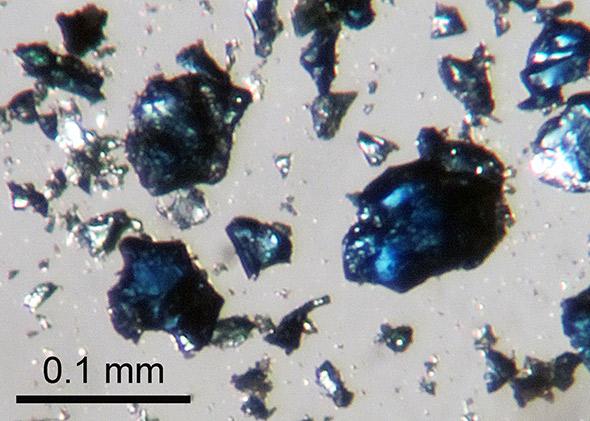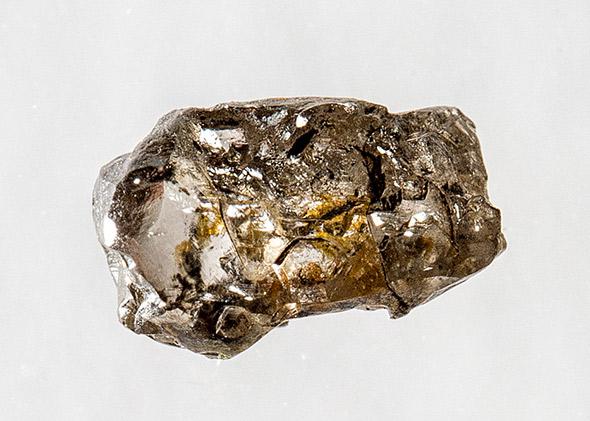The journal Nature announced a spectacular discovery last week. Geophysicists working in Brazil uncovered a diamond containing the mineral ringwoodite that came steaming out of a volcano, settling a decadeslong dispute about the composition of the Earth. It’s difficult to overstate the importance and improbability of this event—it’s a bit like a Higgs boson tonking a physicist in the face, then falling into her lap so she just had to hold it up for the rest of the scientific community to see. (I know that’s impossible. You don’t have to email me.)
The dispute concerned whether there is water in the transition zone—the portion of the Earth’s mantle 250 to 410 miles underground, between the upper and lower mantle. Skeptics have argued that there is no obvious way for water to exist at that depth. When the Earth’s crust drops into the mantle as part of the ongoing rise and fall of plate tectonics, the water is quickly expelled. We know this, in part, because the mantle is rich in olivine, which cannot hold water under the temperature and pressure conditions of the upper mantle—the portion from the bottom of the crust down to 250 miles underground. When the crust sinks, its water shouldn’t be able to go with it. Instead, it appears to mix with the molten rock at the interface of the crust and mantle that facilitates the shifting of the Earth’s plates.
But a funny thing happens to olivine when it gets deeper into the Earth. Laboratory experiments have shown that, when placed under intense pressure—the sort of pressure exerted by a 250-mile layer of rock—olivine changes its structure to a mineral known as wadsleyite. At around 310 miles underground, wadsleyite is pressed into ringwoodite. Both substances are capable of holding water.
Just because those minerals must be in the transition zone and capable of holding water doesn’t mean water is present, but evidence for that proposition has been building. Steve Jacobsen, a geophysicist at Northwestern University, uses a diamond-tipped vice to press olivine into ringwoodite and then determines some of the properties of material when it contains water. He can, for example, bounce tiny seismic waves off of hydrated ringwoodite. Armed with that reference data, seismologists have shown that the changes in waves passing through the Earth’s mantle strongly suggest that ringwoodite is present and that it’s holding water.

Courtesy of Steve Jacobsen/Northwestern University
We had no way of finding the water directly until a volcano spewed out the evidence for us—a water-soaked bit of ringwoodite encased in a diamond. Few people expected such a thing to happen, because in an ordinary volcanic eruption, magma moves very slowly. As it rises toward the surface, the pressure drops, allowing ringwoodite and wadsleyite to revert to bone-dry olivine. A “kimberlite” eruption, however—the kind that seems to have ejected the recently found ringwoodite—is a higher-speed event that probably allowed the ringwoodite to maintain its structure.
Until last week’s announcement, ringwoodite had been observed in only two places on Earth: in scientific laboratories and in bits of fallen meteorite. Asteroids and meteorites contain many of the same minerals as the Earth’s mantle.

Courtesy of Steve Jacobsen/Northwestern University
Some of the coverage of the Nature paper has emphasized the volume of water likely to be present in the transition zone—possibly more than is present in all of the oceans combined. But there are a few caveats. First, we’ll never get to it. It’s at least 250 miles underground, and we’ve never drilled deeper than seven. More importantly, it’s not in a useful form. Jacobsen explains that slate (the stuff we use to make chalkboards, not the Web magazine) is about 13 percent water by weight. That means a five-pound chunk of slate contains enough ounces of water to quench your thirst, but you’d never attempt to drink a chalkboard. The same is true for the “water” in the transition zone. You can’t drink it or swim in it or use it in a steam turbine. It’s bound up in rock. It’s also evenly distributed at very low levels across large areas, making it impossible to extract efficiently even if we could get to it.
Just because it’s not commercially useful doesn’t mean it’s unimportant. For one thing, the mantle is likely doing us an enormous favor by holding so much water. If the water were released into the crust, most of Earth’s landmass would be submerged. The discovery may also help us to better understand how plate tectonics got started and the mechanics of earthquakes and volcanic eruptions.
“Plate tectonics, in a sense, built the Earth’s atmosphere,” explains Jacobsen. Volatile atoms in the atmosphere, like hydrogen, came from inside the Earth. The dynamic state of the mantle and the shifting of the plates helped de-gas the planet. The creation of our atmosphere also established pressure conditions that made liquid water possible on the Earth’s surface. As we improve our ability to survey the near-universe for habitable planets, an improved understanding of plate tectonics will aid the search.
The blue planet got a little bit bluer last week. It might not solve the water shortage in Tucson, Ariz., but it’s still a pretty big deal.
